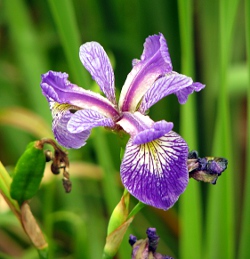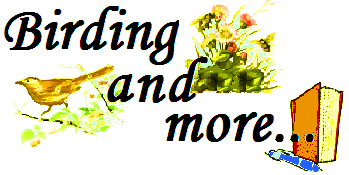 Newsletter
Newsletter
2010
/ Issue 11
IN THIS ISSUE: HOW TO PHOTOGRAPH WILD BIRDS - Part 3
In this instalment, I'll be discussing HOW TO CAPTURE THE RIGHT POSE.
Wild
bird photography presents a unique set of challenges. It's not like taking pictures of sunsets, mountain
ranges, flowers, or people. First, you have to find the birds, then hope
they're sitting on a good perch, and then hope they don't fly off before
you can snap their photo. In light of that, what are the chances that
they will also strike a good pose?
Getting a good pose
is difficult - no doubt about it - but perhaps not as hard as you may
think. Just knowing what constitutes a good pose is half the battle. As
I've mentioned many times, birds are inherently difficult
The Classic Pose
So what are the elements of a good pose. Let's look at this photo of a
Hairy Woodpecker that I took. It is a classic bird pose. The 3/4 angle
offers a good view of most of the bird's feathers: the back, wing,
belly, tail, and head. The head is profiled, the feet are partially
visible, and there is a nice catch light in the eye. It also benefits
from an out-of-focus background which draws the eye to the in-focus
subject.
Most birds are
constantly looking around while perched, so the basic technique for
capturing a good pose is to manoeuvre yourself so that you have a good
angle on the bird's body, and wait for the bird to turn its head so that
you can get its profile. Having the sun behind you, or a strong flash
will eliminate any annoying shadows and give a nice catch light in the
bird's eye.
Natural
Behaviour Poses
Another very attractive way to capture a bird, is to frame it in a
natural setting. This is further enhanced if the bird is singing,
preening, doing a courtship display, or some other behaviour. These
shots are interesting and reveal more about the bird than just how it
looks. These shots should still be well lit, taken at a good angle, and
show as much of the bird as possible. However, if some leaves in the
foreground are covering some of the bird (as in this photo of a Yellow
Warbler) it should not been seen as a negative element. The setting is
an integral part of the shot, especially in these types of photos. It
gives the viewer a glimpse of just how the bird looks in its natural
habitat.
Next issue: CHOOSING A SUITABLE CAMERA AND LENS
WILD IRIS
This one is for Elaine.
Knowing her love of wildflowers, I thought I'd showcase this beautiful
Wild Iris that I came across Sunday morning in the wetlands of the H. R. Frink Centre - Garry.
***********************
THE READERS' PATCH
...more on the topic of bird baths
In response to the article in our last issue, Susan Rollinson of Belleville offers some good advice about how to protect the garden birds and how to prevent the mosquitoes from breeding.
Susan writes:
Pedestal bird baths are too low and attract cats. Bird baths should be
too high for cats to leap onto. Feral cats are everywhere and pounce
when a bird is least guarded. Use hanging baths, or place the pedestal
baths on something to raise their height and keep them out of jumping
reach.
Secondly, add a water wiggler to your bath. ...it ripples the water
constantly (solar powered) that both attracts birds as they like moving
water, and prevents west nile virus as the water is not sitting still.
...thanks Susan for this great advice!
***********************
The Readers
Patch is
a space for your photos, stories, and/or comments.
Send anything
you'd like to share with us to: newsletter@birdingandmore.com

Elaine's sister Brenda and her husband Bill have a wonderful garden
that features
many bird feeders. Two weeks ago,
New posts have been added to the Birding and more blog.
New photos have been added to
the following galleries:
Backyard Birds, Birds in the Wild, Wildlife, and Our Garden
FUN FACTS ABOUT BIRDS
A bird that barks instead of sings.
It's true. In 1998, ornithologist Robert S. Ridgely
discovered a black and white duck-like bird in Ecuador that actually
barks like a dog! The barking is the bird's natural sound, not a learned
imitation. The species has been named Antpitta avis canis Ridgely
SURPRISING BLUE JAY BEHAVIOUR
Recently, while we were
enjoying some Egg McMuffins and coffee on our patio, Elaine and I
witnessed a remarkable Blue Jay behaviour. I had just put out some
peanuts (in the shell) for the squirrels and jays, and with little delay
a group of Blue Jays began taking turns grabbing the peanuts and flying
up into the nearby
 trees
to peck them open. Elaine and I had seen this many times, but what
we hadn't seen before was a Jay grabbing a peanut and hiding it in the
lawn! The Jay in question would take his peanut, fly down to the lawn,
push the nut deep into the grass, and then using two or three bits of
dried leaves, camouflage the location.
trees
to peck them open. Elaine and I had seen this many times, but what
we hadn't seen before was a Jay grabbing a peanut and hiding it in the
lawn! The Jay in question would take his peanut, fly down to the lawn,
push the nut deep into the grass, and then using two or three bits of
dried leaves, camouflage the location.
Whirling Butterflies (Gaura) is a perennial that I've planted twice now but it hasn't made it through either winter. I'm trying again – just planted one yesterday – and this time I will
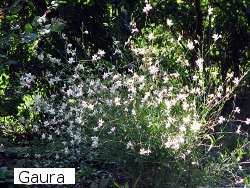 mulch it well for the winter so hopefully this one will make it.
Apparently Zone 5 winters can be too hard on Gaura but the
white-petalled Whirling Butterflies is considered to be hardy so keep
your fingers crossed for me.
mulch it well for the winter so hopefully this one will make it.
Apparently Zone 5 winters can be too hard on Gaura but the
white-petalled Whirling Butterflies is considered to be hardy so keep
your fingers crossed for me.
We were at my sister's last weekend and ended up bringing home several plants (courtes
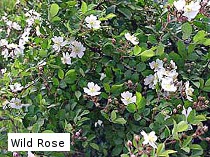 y
of her garden)
to add to our
flowerbeds. We now have three Wild Rose Bushes, two with pink flowers
and one with white, a flowering
Raspberry Bush, and two Wild Grape vines. Even though they were just
y
of her garden)
to add to our
flowerbeds. We now have three Wild Rose Bushes, two with pink flowers
and one with white, a flowering
Raspberry Bush, and two Wild Grape vines. Even though they were just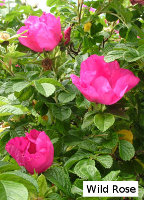 planted a week ago the Wild Rose and Flowering Raspberry stems and
leaves are looking firm and I'm quite hopeful that they'll adjust and do
well. We'll have to wait a while
to see if the Wild Grape vines will develop new roots and become
well-established before winter.
Right now
they're
rather sorry-looking but we've got lots of time!
planted a week ago the Wild Rose and Flowering Raspberry stems and
leaves are looking firm and I'm quite hopeful that they'll adjust and do
well. We'll have to wait a while
to see if the Wild Grape vines will develop new roots and become
well-established before winter.
Right now
they're
rather sorry-looking but we've got lots of time!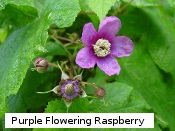 It
seems like I
keep finding
plants to add to our
garden even though I
say that we're pretty much done...
and I do think we're pretty much done
It
seems like I
keep finding
plants to add to our
garden even though I
say that we're pretty much done...
and I do think we're pretty much done
If you liked our newsletter
please pass it along to your friends and family.
Subscriptions are free! Just send an
email to: newsletter@birdingandmore.com
Copyright © 2010 Garry Kirsch www.birdingandmore.com
If you wish to cancel your subscription send an email to unsubscribe@birdingandmore.com

